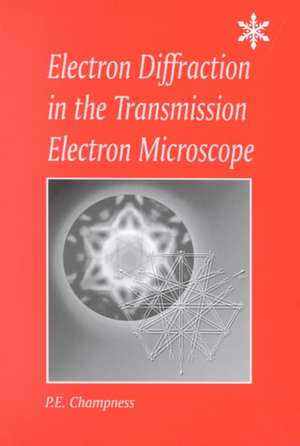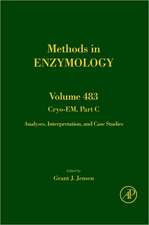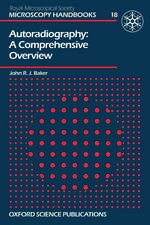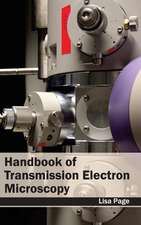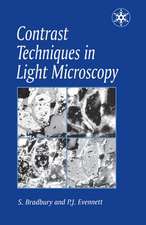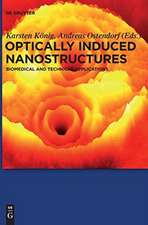Electron Diffraction in the Transmission Electron Microscope
Autor P.E. Champnessen Limba Engleză Paperback – 15 iun 2001
Preț: 565.01 lei
Preț vechi: 664.71 lei
-15% Nou
Puncte Express: 848
Preț estimativ în valută:
108.12€ • 113.69$ • 89.33£
108.12€ • 113.69$ • 89.33£
Carte tipărită la comandă
Livrare economică 17 aprilie-01 mai
Preluare comenzi: 021 569.72.76
Specificații
ISBN-13: 9781859961476
ISBN-10: 1859961479
Pagini: 186
Dimensiuni: 156 x 234 x 10 mm
Greutate: 0.36 kg
Ediția:New.
Editura: CRC Press
Colecția Garland Science
ISBN-10: 1859961479
Pagini: 186
Dimensiuni: 156 x 234 x 10 mm
Greutate: 0.36 kg
Ediția:New.
Editura: CRC Press
Colecția Garland Science
Public țintă
Postgraduate and UndergraduateCuprins
Abbreviations -- List of symbols -- Preface -- 1. Diffraction and the electron microscope -- How a lens forms a diffraction pattern -- Introduction to diffraction in the TEM -- SAD in the TEM -- Low- (or small-) angle diffraction -- Limitations to the accuracy of selected-area diffraction -- Diffraction using small probes -- Spatial resolution -- Problems with specimens -- Specimen preparation -- Beam damage -- Obtaining and recording a SAD pattern in the TEM -- Obtaining a CBED pattern -- TEM mode -- STEM mode -- Alignments that are important for diffraction -- 2. The reciprocal lattice and Bragg's Law -- Electrons as waves -- Interference of waves -- Bragg's Law -- The reciprocal lattice -- The 180° ambiguity in indexing the diffraction pattern -- Diffraction patterns from polycrystalline materials -- Diffraction patterns from amorphous materials -- Systematic absences -- Standard patterns -- Cubic patterns -- Hexagonal close-packed patterns -- Patterns from the diamond structure -- Computer indexing of electron diffraction patterns -- Input data -- Measuring the pattern and indexing it - an example -- Calibration of the camera constant -- Calibration of the rotation between the image and the diffraction pattern -- Using electron diffraction to identify unknown phases -- Exercises -- 3 The reflecting sphere -- The reflecting sphere -- Obtaining orientation relationships -- Second-phase particles or precipitates -- Twinned crystals -- Determining habit and composition planes -- The importance of crystal orientation -- Dark-field imaging -- Exercises -- 4 Finding your way around reciprocal space: Kikuchi diffraction -- How Kikuchi lines form -- The determination of the deviation parameter s -- Kikuchi maps and their uses -- Finding the exact orientation of the crystal -- Exercises -- 5 The intensities of reflections -- The atomic scattering amplitude, f -- The structure factor, Fhkl -- Systematic absences due to lattice type -- Crystal with a simple structure -- Systematic absences due to translational symmetry elements -- The kinematic and dynamical theories of electron diffraction Measuring the structure factor, Fhkl, and the extinction distance -- Exercises -- 6 Determination of the Bravais lattice, point group and space group -- Determination of the crystal system from conventional electron diffraction patterns -- Convergent-beam methods -- Zonal repeats parallel to the electron beam -- Geometry of CBED patterns from HOLZs -- The symmetry of CBED patterns -- The Tanaka method -- Exercises -- 7. The fine structure in electron diffraction patterns -- Double diffraction -- Double diffraction of 'forbidden' reflections -- Double diffraction of spots from precipitates and twins -- Detection of double diffraction in the microscope -- Diffraction from small particles -- The distribution of streaks in the diffraction pattern -- The effects of elastic strain -- Diffraction from ordered structures -- Long-range order -- Short-range order -- Periodic and modulated structures -- Spinodal decomposition and other compositional modulations -- Periodic antiphase domain boundaries -- Regular dislocation arrays -- Incommensurate structures -- Planar and linear defects -- Thermal diffuse scattering -- Exercises -- Appendices -- Appendix A: Some basic crystallography -- Appendix B: An introduction to space groups -- Appendix C: Some useful crystallographic relationships -- Appendix D: Relativistic electron wavelengths -- Appendix E: Mathematical definition of the reciprocal lattice -- Appendix F: Computer programs concerning electron diffraction -- Appendix G: Answers to exercises -- Appendix H: References -- Index.
Notă biografică
Pamela Champness graduated from Cambridge University in Natural Sciences (Mineralogy) in 1964 and was awarded a PhD in Mineralogy from Cambridge in 1969. She has recently retired as Reader in Crystallography at the Department of Earth Sciences, University of Manchester and is now an Honorary Research Fellow. Her main research interests are in the applications of transmission electron microscopy to phase transformations in minerals
Recenzii
'Dr Champness has mangaged to include a host of excellent features not readily found in other texts...perhaps the strongest feature of the book is that the plentiful examples are taken from materials with a wide range of crystal structures. Make sure it is available in your EM laboratory.' - Journal of Microscopy
'This book contains rich application examples from a specialist and should be a very useful introductory text to graduate students as well as a handy reference book for research specialists.' - Microscopy and Analysis
'Dr Champness has managed to include some quite specialized topics...a nice characteristic is the inclusion of features and topics not easily founded in other texts. The book is carefully written reflecting the experience of many years of teaching experience...I anticipate that this book will be a useful addition to many bookshelves'. - Micron 34
'Dr Champness has mangaged to include a host of excellent features not readily found in other texts ... Perhaps the strongest feature of the book is that the plentiful examples are taken from materials with a wide range of crystal structures. Make sure it is available in your EM laboratory.' - Journal of Microscopy
'This book contains rich application examples from a specialist and should be a very useful introductory text to graduate students as well as a handy reference book for research specialists.' - Microscopy and Analysis
'This book contains rich application examples from a specialist and should be a very useful introductory text to graduate students as well as a handy reference book for research specialists.' - Microscopy and Analysis
'Dr Champness has managed to include some quite specialized topics...a nice characteristic is the inclusion of features and topics not easily founded in other texts. The book is carefully written reflecting the experience of many years of teaching experience...I anticipate that this book will be a useful addition to many bookshelves'. - Micron 34
'Dr Champness has mangaged to include a host of excellent features not readily found in other texts ... Perhaps the strongest feature of the book is that the plentiful examples are taken from materials with a wide range of crystal structures. Make sure it is available in your EM laboratory.' - Journal of Microscopy
'This book contains rich application examples from a specialist and should be a very useful introductory text to graduate students as well as a handy reference book for research specialists.' - Microscopy and Analysis
Descriere
This book is a practical guide to electron diffraction in the transmission electron microscope (TEM). Case studies and examples are used to provide an invaluable introduction to the subject for those new to the technique. The book explains the basic
